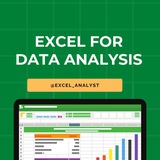𝐏𝐨𝐰𝐞𝐫 𝐁𝐈 𝐫𝐞𝐩𝐨𝐫𝐭 𝐢𝐬 𝐫𝐮𝐧𝐧𝐢𝐧𝐠 𝐬𝐥𝐨𝐰𝐥𝐲. 𝐖𝐡𝐚𝐭 𝐬𝐭𝐞𝐩𝐬 𝐰𝐨𝐮𝐥𝐝 𝐲𝐨𝐮 𝐭𝐚𝐤𝐞 𝐭𝐨 𝐝𝐢𝐚𝐠𝐧𝐨𝐬𝐞 𝐚𝐧𝐝 𝐟𝐢𝐱 𝐭𝐡𝐞 𝐩𝐫𝐨𝐛𝐥𝐞𝐦?
👇👇
https://t.iss.one/PowerBI_analyst/240
👇👇
https://t.iss.one/PowerBI_analyst/240
Telegram
Microsoft Power BI | Tableau | Data Visualization
𝐏𝐨𝐰𝐞𝐫 𝐁𝐈 𝐫𝐞𝐩𝐨𝐫𝐭 𝐢𝐬 𝐫𝐮𝐧𝐧𝐢𝐧𝐠 𝐬𝐥𝐨𝐰𝐥𝐲. 𝐖𝐡𝐚𝐭 𝐬𝐭𝐞𝐩𝐬 𝐰𝐨𝐮𝐥𝐝 𝐲𝐨𝐮 𝐭𝐚𝐤𝐞 𝐭𝐨 𝐝𝐢𝐚𝐠𝐧𝐨𝐬𝐞 𝐚𝐧𝐝 𝐟𝐢𝐱 𝐭𝐡𝐞 𝐩𝐫𝐨𝐛𝐥𝐞𝐦?
👉 Check Data Volume: Large datasets can slow down your report. Try to reduce the amount of data by filtering or aggregating it.
👉 Optimize Data Model: Remove any…
👉 Check Data Volume: Large datasets can slow down your report. Try to reduce the amount of data by filtering or aggregating it.
👉 Optimize Data Model: Remove any…
👍4
Why is Excel Often the Starting Point for SQL ?
Here's how Excel can help you before you dive into SQL:
✔️ 𝐕𝐋𝐎𝐎𝐊𝐔𝐏 = 𝐒𝐐𝐋 𝐉𝐎𝐈𝐍𝐒
In Excel, we use VLOOKUP to bring together data from different sheets. It's just like using JOINS in SQL to get data from more than one table.
✔️ 𝐒𝐔𝐌 𝐚𝐧𝐝 𝐂𝐎𝐔𝐍𝐓 𝐟𝐨𝐫 𝐒𝐐𝐋 𝐐𝐮𝐞𝐫𝐢𝐞𝐬
Excel's SUM and COUNT functions are like practice for SQL queries. They help you add up and count things, which is what you often do in SQL.
✔️ 𝐅𝐈𝐋𝐓𝐄𝐑 𝐒𝐭𝐚𝐭𝐞𝐦𝐞𝐧𝐭𝐬 & 𝐖𝐇𝐄𝐑𝐄 𝐢𝐧 𝐒𝐐𝐋
Excel's 𝐅𝐈𝐋𝐓𝐄𝐑 statements let you make choices with your data. This is similar to using WHERE in SQL to pick specific data.
✔️ 𝐇𝐚𝐧𝐝𝐥𝐢𝐧𝐠 𝐃𝐚𝐭𝐞𝐬 𝐚𝐧𝐝 𝐓𝐞𝐱𝐭
Both Excel and SQL have ways to work with dates and text. Learning these in Excel first can make it easier when you switch to SQL.
✔️ 𝐏𝐢𝐯𝐨𝐭 𝐓𝐚𝐛𝐥𝐞𝐬 & 𝐆𝐑𝐎𝐔𝐏 𝐁𝐘 𝐢𝐧 𝐒𝐐𝐋
Ever used pivot tables in Excel? They're a good start for understanding the GROUP BY function in SQL, which helps you organize and summarize data.
✔️ 𝐗𝐋𝐎𝐎𝐊𝐔𝐏 & 𝐇𝐲𝐩𝐞𝐫𝐥𝐢𝐧𝐤𝐬
Excel's XLOOKUP and hyperlinks are like SQL's ways of finding and linking data. They give you a peek into how SQL finds and connects information.
Learning Excel first makes SQL easier to understand. It's not just about learning a tool, it's about getting ready for the bigger world of data!
You will be asked questions on SQL in interviews for sure! Make sure to practice 2-3 questions daily, it can't be mastered overnight!
Share our channel link with your true friends: https://t.iss.one/excel_analyst
Hope this helps you 😊
Here's how Excel can help you before you dive into SQL:
✔️ 𝐕𝐋𝐎𝐎𝐊𝐔𝐏 = 𝐒𝐐𝐋 𝐉𝐎𝐈𝐍𝐒
In Excel, we use VLOOKUP to bring together data from different sheets. It's just like using JOINS in SQL to get data from more than one table.
✔️ 𝐒𝐔𝐌 𝐚𝐧𝐝 𝐂𝐎𝐔𝐍𝐓 𝐟𝐨𝐫 𝐒𝐐𝐋 𝐐𝐮𝐞𝐫𝐢𝐞𝐬
Excel's SUM and COUNT functions are like practice for SQL queries. They help you add up and count things, which is what you often do in SQL.
✔️ 𝐅𝐈𝐋𝐓𝐄𝐑 𝐒𝐭𝐚𝐭𝐞𝐦𝐞𝐧𝐭𝐬 & 𝐖𝐇𝐄𝐑𝐄 𝐢𝐧 𝐒𝐐𝐋
Excel's 𝐅𝐈𝐋𝐓𝐄𝐑 statements let you make choices with your data. This is similar to using WHERE in SQL to pick specific data.
✔️ 𝐇𝐚𝐧𝐝𝐥𝐢𝐧𝐠 𝐃𝐚𝐭𝐞𝐬 𝐚𝐧𝐝 𝐓𝐞𝐱𝐭
Both Excel and SQL have ways to work with dates and text. Learning these in Excel first can make it easier when you switch to SQL.
✔️ 𝐏𝐢𝐯𝐨𝐭 𝐓𝐚𝐛𝐥𝐞𝐬 & 𝐆𝐑𝐎𝐔𝐏 𝐁𝐘 𝐢𝐧 𝐒𝐐𝐋
Ever used pivot tables in Excel? They're a good start for understanding the GROUP BY function in SQL, which helps you organize and summarize data.
✔️ 𝐗𝐋𝐎𝐎𝐊𝐔𝐏 & 𝐇𝐲𝐩𝐞𝐫𝐥𝐢𝐧𝐤𝐬
Excel's XLOOKUP and hyperlinks are like SQL's ways of finding and linking data. They give you a peek into how SQL finds and connects information.
Learning Excel first makes SQL easier to understand. It's not just about learning a tool, it's about getting ready for the bigger world of data!
You will be asked questions on SQL in interviews for sure! Make sure to practice 2-3 questions daily, it can't be mastered overnight!
Share our channel link with your true friends: https://t.iss.one/excel_analyst
Hope this helps you 😊
👍25❤5🔥1
Formulas and Functions
Key Differences
Formulas: Custom calculations created by the user using operators, cell references, and constants.
Functions: Predefined formulas in Excel designed to perform specific tasks, like summing values or finding the average.
Key Differences
Formulas: Custom calculations created by the user using operators, cell references, and constants.
Functions: Predefined formulas in Excel designed to perform specific tasks, like summing values or finding the average.
👍19❤1
Data people, repeat after me:
Excel is not a database.
Excel is not a database.
Excel is not a database.
Excel is not a database.
Excel is not a database.
Excel is not a database.
Excel is not a database.
Excel is not a database.
Excel is not a database.
Excel is not a database.
Excel is not a database.
Excel is not a database.
Excel is not a database.
Excel is not a database.
Excel is not a database.
Excel is not a database.
Excel is not a database.
Excel is not a database.
Excel is not a database.
Excel is not a database.
🤣69👍20😁17❤4
These 10 tips will make you feel like an expert and increase your productivity 100X:
1. Excel Keyboard Shortcuts:
These save a lot of time.
For example, you can press "Ctrl+C" to copy, "Ctrl+V" to paste, and "Ctrl+Z" to undo.
There are many more, so check out this cheatsheet:
Excel for Data Analysis
1. Excel Keyboard Shortcuts:
These save a lot of time.
For example, you can press "Ctrl+C" to copy, "Ctrl+V" to paste, and "Ctrl+Z" to undo.
There are many more, so check out this cheatsheet:
Excel for Data Analysis
👍10❤5😁1
